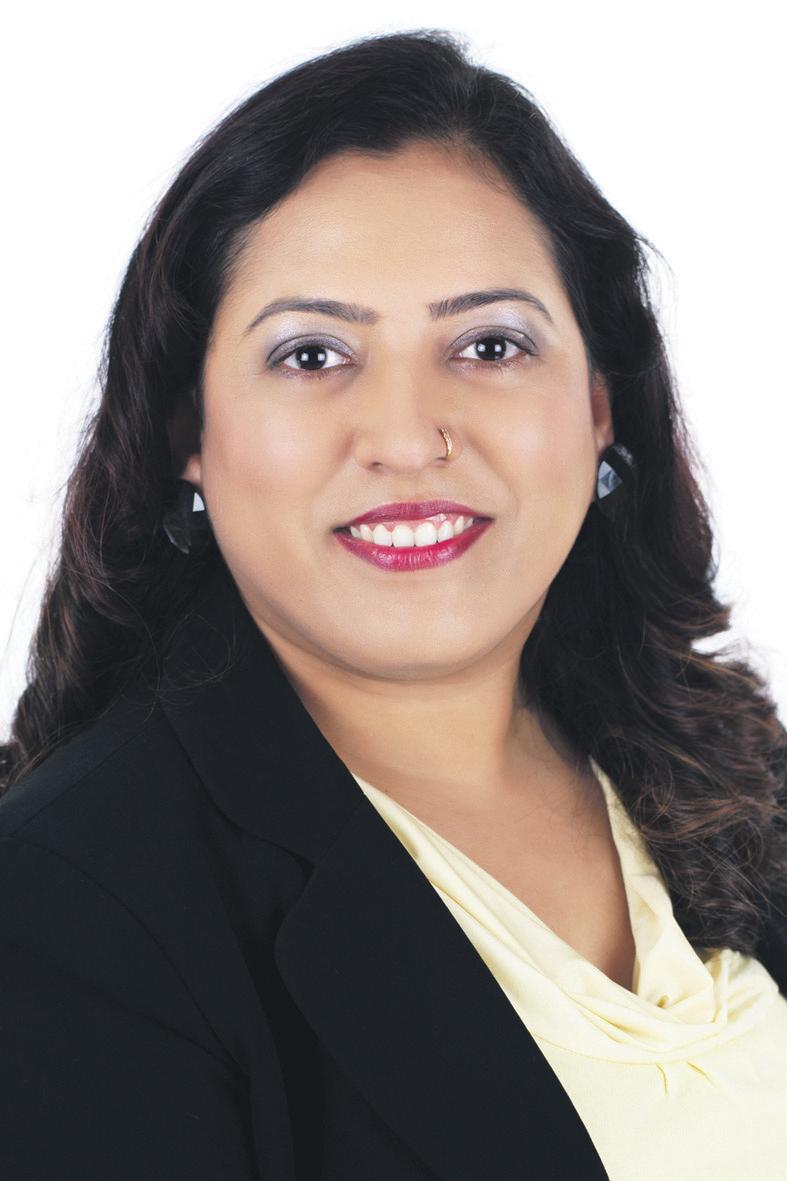
16 minute read
Common themes, but uncertain actions
from 2013-12 Sydney (1)
by Indian Link
Indian-origin Australians offer their perspective of how Indo-Oz relations can be mutually nurtured
Jayantee calls then them the 3 Cs –Chaos, Corruption and Cronyism, which is tarnishing the brand image of India
BY JYOti ShANKAr
Did you know that: There are 450,000 people of Indian origin now living in Australia? This is 2% of the Australian population.
• Victoria is the state where most people of Indian origin live
• The first Indians arrived in Australia on Captain Cook’s ship in 1770
• Some Indians were sent to Australia as convicts by the British colonial government in the early 19th century
• 138,700 people from India visited Australia as tourists in 2010, and this figure has shown an increasing trend
• Indian students are now the second-largest source of international students in Australia
• Three times more money (AUD20.4 billion) has come from India into Australia than vice versa (AUD6.88 billion) in 2010-2011
• Indians are three times more likely to have a university degree compared to the other Australians
• The unemployment rate among Indian-Australians stands high at 6.2%, compared to the national average of 5.1%
• The median weekly income of Indians at AUD663 is higher than the average of AUD597?
• Only about 13% of Indians volunteer their time as compared to the national average of 36%?
Making sense of these statistics gathered from sources such as the Australian Bureau of Statistics, Department of Foreign Trade and Department of Immigration and Citizenship, as well as insights gained from interviews with 25 immigrants of Indian origin, is what Jayantee Mukherjee Saha, has attempted to do.
Jayantee is the Director of Aei4eiA, a Sydney-based management research, training and consultancy firm. The recently released resultant report, Experience Australia: Reflections from the Indian Community, is a smorgasbord of interesting facts and a sprinkling of interviews with some of the more prominent and successful members of our community. Based on these, Jayantee has drawn certain conclusions about the Indian community in Australia, and what can be done to maintain a mutually sustainable relationship between the two countries.
India has been recognised as one of the countries Australia needs to engage with in the Asian century, but this engagement will not come easily on account of a number of factors identified in the report. Jayantee calls then them the 3 Cs – Chaos, Corruption and Cronyism, which is tarnishing the brand image of India. “This report is only the first step in the three-pronged approach that my organisation is launching –Analysis, Awareness and Action, the report being the Analysis phase,” states Jayantee. Her firm, Aei4eiA, derives its name from the Greek word aeiforeia meaning ‘sustainability’. It aims to explore how India and Australia could forge and sustain a mutually beneficial relationship.
There is no dearth of qualified, intelligent and well-spoken Indians, but it is often found that Indian delegations to Australia are made of people who have been chosen for qualities other than these, presenting a poor image of India. By highlighting the stories of some of the individuals who have made their mark in Australia, Jayantee wishes to understand the common themes that emerge from these stories. These are individuals who have risen in their individual fields through hard work, participation in the community, and by understanding the nuances of living in the host country.
The sample size of 25 that this report has used to derive these conclusions is hardly a representative sample of the Indian population in Australia, but Jayantee accepts this shortcoming. However, at the same time she argues that these individuals are in a way representative of a much larger number of people, as many are community leaders in various states. Some of the individuals whose in-depth interviews appear in the report include Dr Tapas Biswas from Canberra; Dr Yadu Singh and Amarinder Bajwa, both from NSW; DLR Prasad from Queensland; Dipen Mitra, from South Australia; and Dr Sanjeev Sabhlok from Victoria. There is no representation from the Northern Territory or Western Australia.
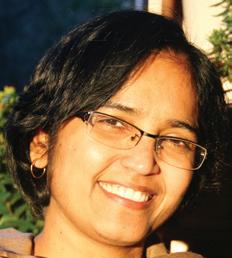
The people interviewed are fairly well-settled migrants and their stories tell us what should be done to foster a better IndoOz relationship, which could be pointers for how migrants can make their assimilation into the country easier. The common themes that emerge are: few are fortunate to have a smooth start; job-seeking is the biggest challenge; shed regional biases and work together as a community; participate in community activities; do proper research before you migrate; take part in government policy-making processes and politics; and be aware that each Indian is an ambassador of India in Australia.
Experiences of migrants from different periods of time (see above graph) are different, but this report does not capture the range of migrant experience. And maybe it would have been balanced to also have the perceptions of Australians about Indians living here. Often, how we perceive others perceiving us, is different from how others may really perceive us!
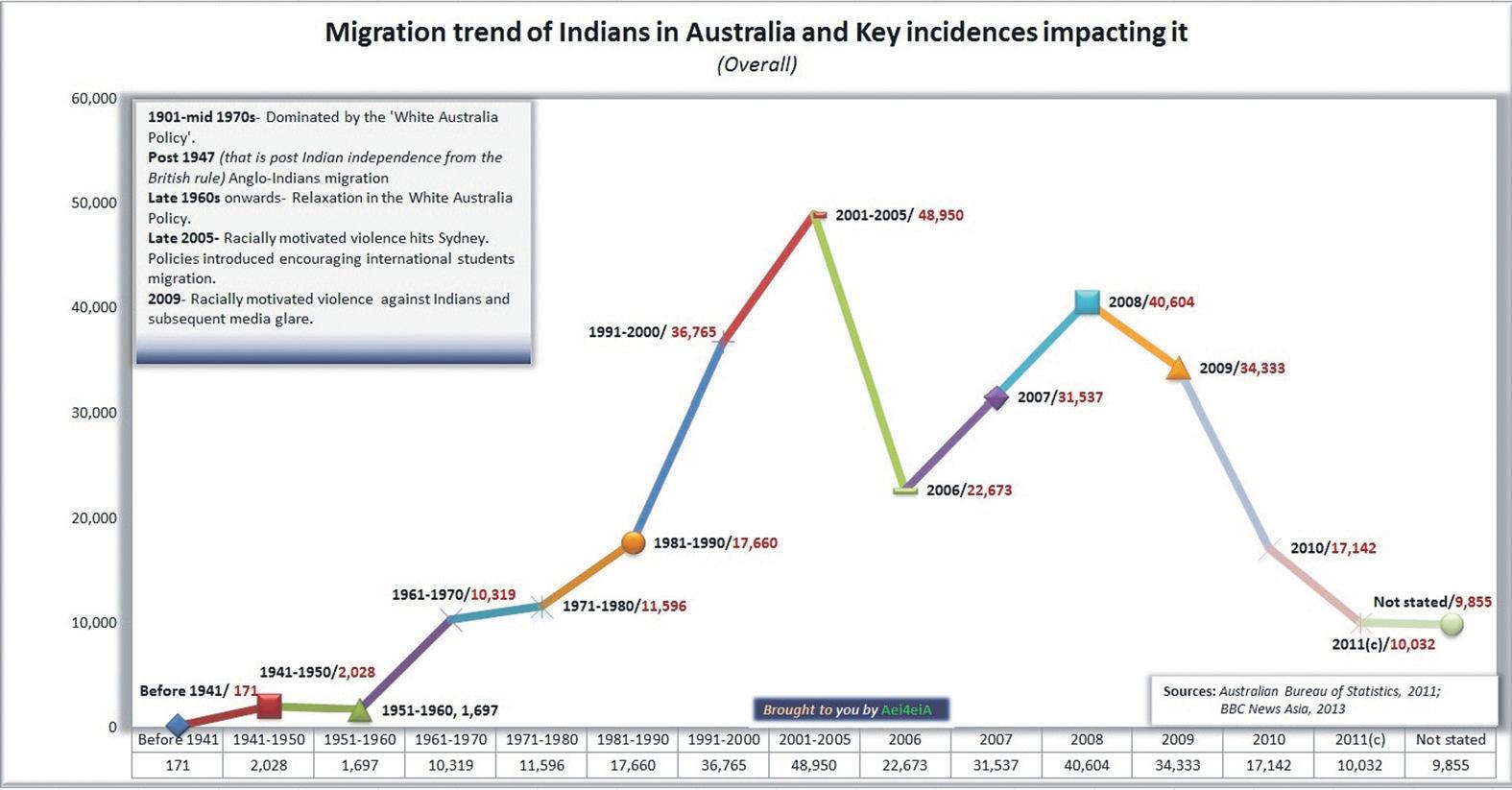
Jayantee believes that there has to be a basis for action and her report is the first step towards action. It is described as a “repository of information and collection sentiments”. The report is interesting for readers who would like to find information about the Indian diaspora in Australia in one place. But where to from here, is the question. Putting together a bunch of facts and interviews would serve little purpose otherwise. When asked about how the findings of the report will be taken further, “watch this space!” is all Jayantee can say at this stage, of her plans. It would be certainly interesting to see the outcomes from the report.
Chidambaram pegs economic growth at 5 percent for 2013-14
The Indian economy is on the path of recovery. Growth will accelerate in the coming quarter and is expected to be around five percent for the current financial year, Finance Minister P. Chidambaram said recently in New Delhi.
The country’s gross domestic product (GDP) growth rose to 4.8 percent in the quarter ending in September as compared to 4.4 percent in the previous quarter, according to latest data from the Central Statistics Office (CSO).
Average growth in the first two quarters of the current financial year stood at 4.6 percent.
Addressing a press conference in the capital, Chidambaram said the economic growth performance in the second quarter of the current financial year was in line with the government’s expectation and was likely to improve significantly in the second half of the year.
“The second quarter GDP growth rate indicates that the economy may be recovering and is on a growth trajectory again,” the finance minister said.
Apart from the second quarter GDP growth numbers, Chidambaram also based his optimism on recovery in exports and a very good improvement in current account deficit situation.
“With the recent improvements in some important sectors like manufacturing, better performance of exports and with the measures taken by the government, the economy can be expected to show further improvement. We expect the growth for the financial year 2013-14 to be 5.0 percent,” the finance ministry said in a statement.
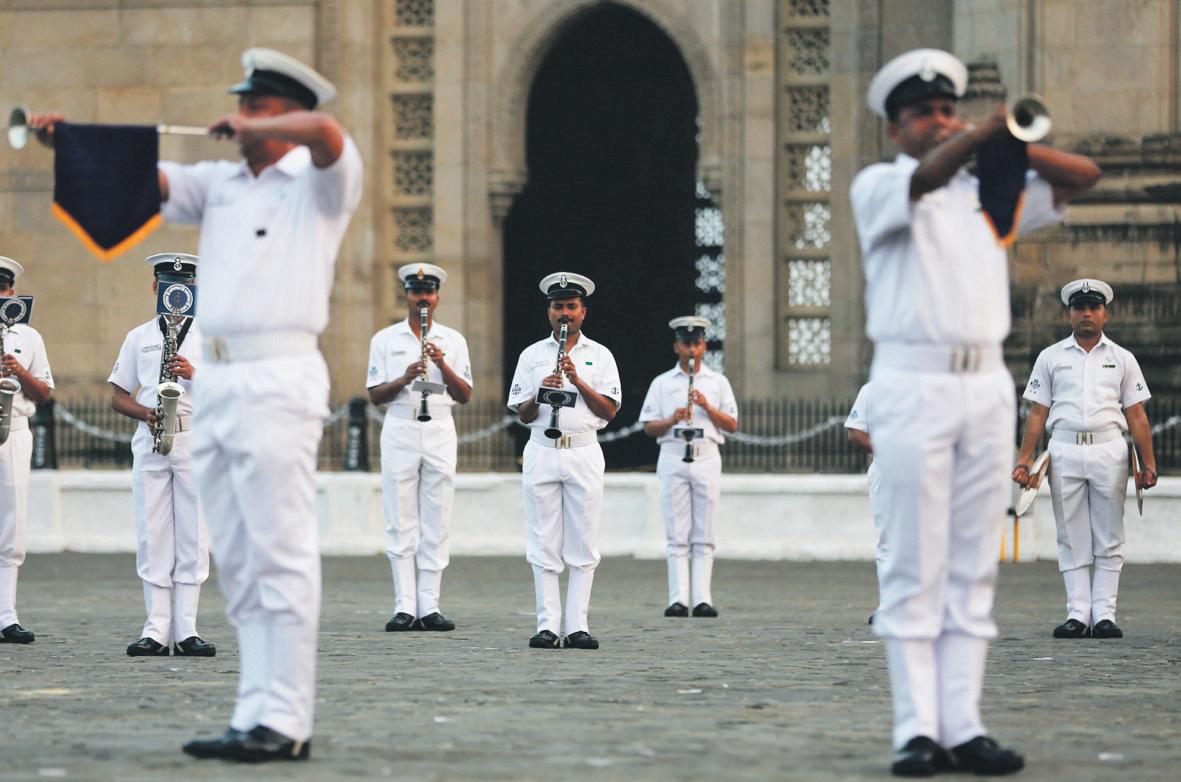
India’s current account deficit falls to $5.2 billion in Q2
India’s current account deficit declined to $5.2 billion in July-September quarter of the current financial year as compared to $21 billion recorded in the corresponding quarter of last year, on the back of rise in exports and decline in gold imports, government data showed recently.
As a proportion of the country’s gross domestic product (GDP), the current account deficit during the quarter under review is 1.2 percent, sharply down from 5 percent recorded in the corresponding quarter in 2012-13, according to data released by the Reserve Bank of India (RBI).
The current account deficit (CAD) was recorded at 4.9 percent of the country’s GDP in the April-June quarter of the current financial year.
“The lower CAD was primarily on account of a decline in the trade deficit as merchandise exports picked up and imports moderated, particularly gold imports,” the RBI said.
On a balance of payment basis, merchandise exports increased by 11.9 percent to $81.2 billion in the second quarter of 2013-14 on the back of significant growth especially in the exports of textiles and textile products, leather and leather products and chemicals.
On the other hand, merchandise imports at $114.5 billion recorded a decline of 4.8 percent in the second quarter of the current financial year as compared with a decline of 3 percent in the second quarter of 2012-13 year-on-year, primarily led by a steep decline in gold imports, which amounted to $3.9 billion as compared to $16.4 billion in the first quarter of 2013-14 and $11.1 billion in the second quarter of 2012-13.
As a result, the merchandise trade deficit (BoP basis) contracted to $33.3 billion in the second quarter of 2013-14 from $47.8 billion a year ago.
29 years later, Bhopal gas victims still wait for justice
It was on the night of Dec 2-3, 1984, that a toxic gas leak from the Union Carbide Corporation’s pesticide plant in the Madhya Pradesh capital killed and maimed thousands of people. Nearly three decades later, victims of the Bhopal gas tragedy are still fighting for justice.
The victims have been waging legal battles demanding more compensation, better treatment facilities and removal of hazardous waste from the site, and jobs for affected people.
Various social groups fighting for justice for the victims of one of the world’s worst industrial disasters are planning to hold a meeting in Bhopal to reiterate their demands.
Most of the victims blame the state and central governments for not paying heed to their needs.
“In the past 29 years, we have been fighting with limited resources but nothing substantial has come out yet. Both the state and central governments have been eye-washing the world on the matter,” said Rachna Dhingra, a member of the Bhopal Group for Information and Action.
Dhingra said 25,000 metric tonnes of toxic waste still lies inside the locked Union Carbide plant in Bhopal.
“So far, only 350 tonnes of waste has been removed and the rest continues to lie inside the plant with none having any answer to when will it be removed,” she said.
“The Madhya Pradesh government has accepted the contamination of groundwater in the region, but no steps have been taken for its disposal,” she said.
The Bhopal gas tragedy killed over 3,500 people in a single night. An estimated 25,000, who were maimed have died over two decades.
Balkrishna Namdeo of the Bhopal Gas Peedit Nirashrit Pension Bhogi Sangharsh Samiti said the worst part is that the culprits behind the tragedy are still at large and the government has failed to put them behind bars.
“The people who were responsible for the whole tragedy have gone scot free and our government did not take any action to punish those responsible for taking so many innocent lives,” Namdeo said.
Victims say the impact of the tragedy can be seen even today as hundreds of children born in the area even now suffer from disabilities.
“There are no jobs, victims are being given substandard medicines in hospitals and children continue to be born with disabilities of all kinds. We have been fighting and will continue for our rights,” stated Rashida Bi, head of the Bhopal Gas Peedit Mahila Stationery Karmchari Sangh.
Indian Mars craft crosses moon orbit
Becoming the farthest object sent by the country into interplanetary space, the Indian spacecraft to Mars crossed the moon’s orbit on Dec 2, on its way towards the red planet, ISRO officials said in Bangalore recently.
“The Mars Orbiter has crossed the distance of the moon’s orbit around 8am and is now the farthest object of India in the interplanetary space,” said a senior space agency official.
As earth’s only natural satellite, the moon is around 384,400 km away and is the fifth largest of its kind in the solar system.
Cruising at 32 km per second in the 680-million km solar orbit, the Orbiter flew over the satellite, crossing its orbit where India’s moon craft Chandrayaan-1 orbited in 2008-09. The spacecraft has cruised a distance of 536,000 km from earth by 5 pm on Dec 2.
“The Orbit is on course and cruising to escape the earth’s sphere of influence, which extends up to 918,347 km in the deep space,” Indian Space Research Organisation (ISRO) director Deviprasad Karnik said in Bangalore.
Scientists at the Indian telemetry, tracking and command network (Istrac) in Bangalore and the Indian Deep Space Network at Bylalu, about 40km from Bangalore, are monitoring the spacecraft’s movement in the sun-synchronous orbit and checking its subsystems.
“The Orbiter has crossed the rubicon never to return, as it was freed from the earth’s gravity on early Dec 1 and is on way for a rendezvous with the red planet,” Karnik said.
The craft was flung into outer space 1.11 am Dec 1 after its engine was fired for 22 minutes for the crucial trans-Mars injection at a velocity (speed) of 648 metres per second.
The deep space network will conduct the first of the four mid-course corrections Dec 11 to ensure the Orbiter stays on course in the sun orbit.
After a nine-month long journey, the spacecraft will enter in mid-September 2014 the Mars sphere of influence, which is around 573,473 km from its surface, in a hyperbolic trajectory.
“When the spacecraft is closest to Mars in mid-September, it will be captured into the Martian orbit through a crucial manoeuvre,” Karnik said.
Transition from the earth’s final orbit to solar orbit was programmed in line with sun’s gravity and laws of the universe to ensure the Orbiter reaches precisely on time to sling into the Martian orbit in midSeptember.
The 1,337 kg Orbiter was launched Nov 5 from Sriharikota spaceport off the Bay of Bengal, about 80 km north east of Chennai, on board a 350-tonne rocket with five scientific instruments, Mars Colour Camera, Methane Sensor, Thermal Infrared Imaging Spectrometer, Lyman Alpha Photometer, and Mars exospheric Netural Composition Analyser.
India became the first Asian country and fourth nation in the world to leap into the interplanetary space with its Rs.450-crore exploratory mission to Mars, about 400 million km from earth.
So far, only Russia, USA and the European Space Agency (ESA) have undertaken such missions.
Japan’s imperial couple floored by grand reception
Japanese Emperor Akihito and Empress Michiko were floored by the “gorgeous and colourful” ceremonial reception accorded to them at Rashtrapati Bhavan in New Delhi recently.
The presence of smartly-turned out personnel of the three Services as well as the horse-mounted Presidential Bodyguards in their red-gold livery, left the Japanese imperial couple “very much impressed”. Sakutaro Tanino, press secretary to the emperor and former envoy to India, said the ceremonial reception was “very big in scale”.
The imperial couple, who are on a six-day state visit to India, later went to Rajghat to pay floral tributes at the samadhi of Mahatma Gandhi.
They had paid tribute at Rajghat during their visit 53 years ago, when they were in India as crown prince and princess of Japan and were in their early 20s, said Tanino.
The emperor and empress during their visit to the Japanese embassy were very impressed at how big the peepul tree, known in Japanese as bo, had grown in the 53 years since they planted it.
Need more American investment into India, says Sibal Communications Minister Kapil Sibal recently called for greater investments from US-based companies in India to create jobs and buying capacity for the local population.
“You need to invest in agriculture, medical (sector), electronics and education. Unless you help Indian economy, you won’t be able to increase buying capacity of Indian consumers,” Sibal said at the ninth Indo-US Resurgence Summit held in New Delhi recently.
“The (US investors) are interested in selling their aircraft, defence equipment, but that is not the way to converge in this partnership”.
According to Indian government estimates, the Indo-US trade in merchandise goods for the calendar year 2012 stood at $62.85 billion with balance of trade surplus of $18.18 billion in favour of India.
On the other hand, civilian and military orders placed by India with American companies have created thousands of jobs in the US. Notwithstanding the growing trade ties, the US under its strategic partnership wants to co-develop new systems for civilian and military purposes with India.
The minister, who was speaking at the event organised by the Indo-American Chamber of Commerce (IACC), also attacked the US government policy of restricting visas to Indian information technology (IT) professionals.
“You are a country that talks about liberalisation of global economy and yet you are increasing cost of our IT sector by trying to impose restriction on our people trying to go to US. I don’t think this is the right attitude for partners,” Sibal said.
Sibal added that the trade between the two countries can rapidly expand, and pointed at the enormous opportunity for the companies of two sides to collaborate in areas like manufacture of consumer durables as there is exponential demand in India.
“Today because of high wages cost in China, manufacturing facilities are shifting to India. Japanese are very keen to invest in India, I don’t know why the Americans don’t come forward,” Sibal said.
“The present import bill of crude oil is about $140 billion. Do you think Indian economy can afford to import $300 billion of consumer electronics? We will become bankrupt. We have no choice to build manufacturing sector in our country”.
The day-long summit in the national capital was attended by more than 200 delegates representing companies and institutions from India and the US, including top diplomats and officials from government levels.
According to IACC’s regional president Lalit Bhasin, the summit focussed on enhancing the partnership between the two countries in the sphere of aviation, aerospace, security, services, trade, media and entertainment.
“Our resurgent summit seeks to provide more depth to commercial ties between the world’s most powerful and the world’s largest democracies,” Bhasin said.
“The idea to enhance the partnership to the next level of business, the middlelevel enterprises that are thriving hubs of innovation and employment”.
End travel curbs, demand Pakistan, India journalists
Journalists from India and Pakistan have demanded an end to restrictions on communications and travel between the two countries.
The demand was made in a joint declaration by the Karachi Press Club (KPC) and the Mumbai Press Club at the end of a week-long visit by an Indian journalists’ delegation to Pakistan recently, the Daily Times reported.
KPC president Imtiaz Khan Faran and Mumbai Press Club president Gurbir Singh signed the declaration.
The declaration said the limit of allowing only two accredited journalists in the capitals of either country on a reciprocal basis was “irrational and restrictive”.
It said the severe travel restrictions imposed on journalists have made comprehensive and truthful reporting impossible.
The Indian declaration called the restrictions imposed by both countries on distribution of print editions “archaic and restrictive,” especially since internet editions were freely available throughout the globe.
Bodh Gaya temple dome inlaid with gold
The dome of Bodh Gaya’s 1,500-year-old Mahabodhi temple, Buddhism’s holiest shrine, has been inlaid with nearly 300 kg gold donated by devotees from Thailand, giving the shrine a new look.
“A team of technical experts from
Japan’s Emperor Akihito shakes hand with the President of India, Pranab Mukherjee during a meeting in New Delhi, 2 December. The trip of the Japanese Emperor is to commemorate the 60th anniversary of bilateral diplomatic ties between the two countries
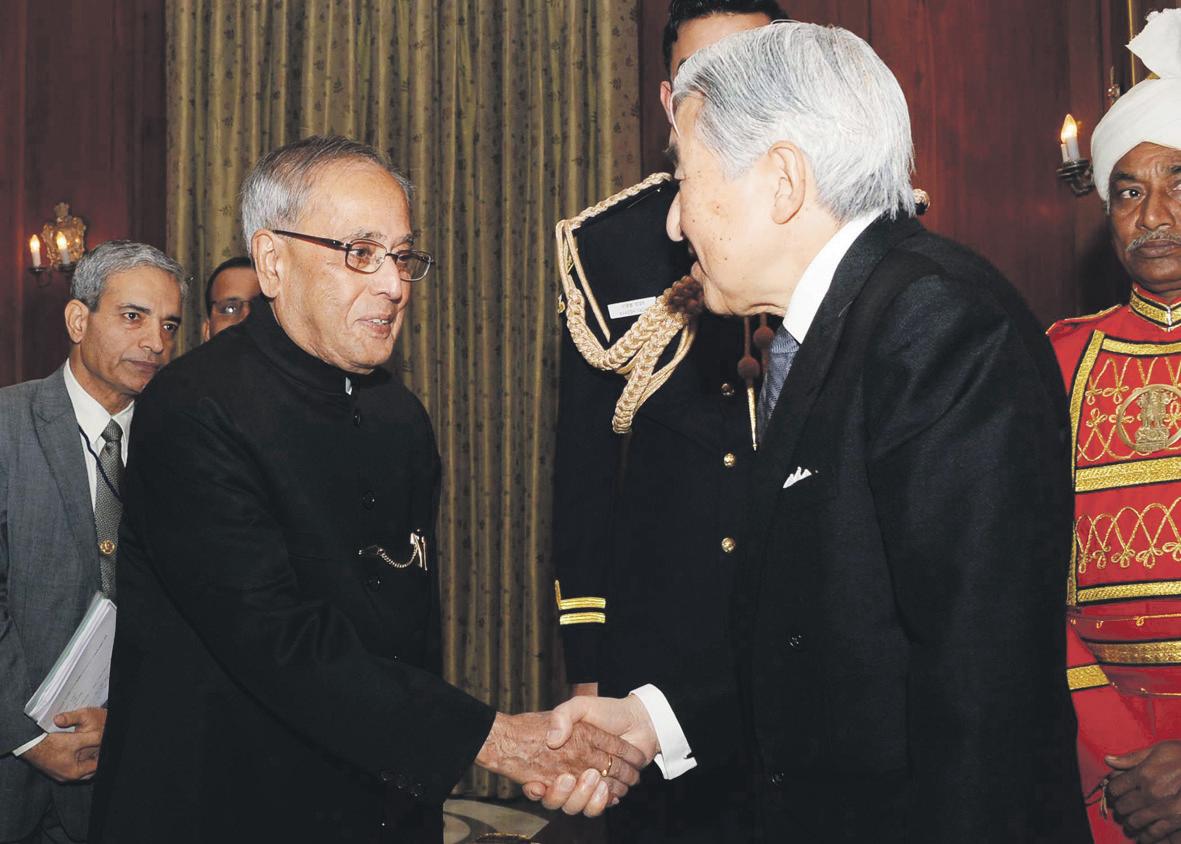
Thailand has completed work to gold-plate the dome and final touches were given to it recently,” the temple’s chief monk Bikhshu Chalinda said.
Chalinda said in a telephone interview from Bodh Gaya, about 110 km from Patna, that the temple’s dome had become more attractive and beautiful after it was inlaid with gold.
“Thanks to the 289 kg of gold donated by the Thai King’s treasury and Buddhist devotees from Thailand, the temple has not only become richer but it has a different look,” he said.
According to him, more than 200 Thai devotees, mostly those who donated gold, were camping in the temple premises to offer prayers.
N. Dorjee, secretary of the Bodh Gaya temple management committee, said work on the dome started in November. A Thai company carried it out, overseen by the Archaeological Survey of India (ASI).
The gold was flown in a special plane from Bangkok.
Dorjee said it was Thai King Bhumibol Atulya who decided last year to cover the temple dome with gold. But it took time to get the ASI’s clearance.
The first phase of the work involving chemical treatment was completed in August to prepare the foundation for gold plating.
The ancient 180 feet structure of the Mahabodhi temple is estimated to have been built between the 5th and 6th century AD.
It was lost and rediscovered in the 19th century by Alexander Cunningham, who founded the ASI in 1861.
Scientific validation of ayurvedic medicines begins in Kerala
CARe Keralam, which recently scientifically validated the anti-diabetes ayurvedic formulation Nishaakathakaadhi Kashayam (NKK) thus facilitating its sale abroad, is going ahead with the same process for other products too, an official said recently in Kochi.
The scientific validation of the diabetes formulation was a first-of-its-kind attempt in the history of ayurveda. Such validation is necessary for the marketing and sale of ayurvedic products in foreign markets.
CARe Keralam, a common facility set up as a joint venture between ayurveda units and the Kerala government, will identify 20 popular formulations for scientific validation with a view to ensuring wider acceptability for ayurvedic medicines.
Many ayurvedic formulations are marketed mostly as food supplements.
CARe Keralam (the Confederation of Ayurvedic Renaissance Keralam Ltd) will be supported by the National Innovation Council and the Council for Scientific and Industrial Research (CSIR) in this attempt to bring international recognition to ayurvedic medicines.
“We have been entrusted this pioneering scientific study by the National Innovation Council. We are ready to take up more such studies to promote the standardisation of ayurveda products, to bring them on par with modern medicines,” CARe Keralam managing director Karimpuzha Raman said.
CARe Keralam, along with CSIR and other national agencies, is also planning a grand ayurveda summit to place this age-old Indian system of medicine in the limelight and identify key products for scientific validation, with the support of the industry.
Spurred by the huge response to its dossier on NKK, the group is also planning to hold a clinical trial of the formulation with a minimum of 500 subjects, to establish the efficacy and safety of the product and officially declare it safe, and in accordance with global standards.
CARe Keralam was established in Koratty in Thrissur district of Kerala with the support of the Department of Ayurveda, Yoga, Naturopathy, Unani, Sidda and Homeopathy (Ayush) of the government of India. It has conducted a comprehensive multidisciplinary study on NKK’s eight raw materials, and the ayurvedic product formulated from them, demonstrating its efficacy on rats. iANS
BY LENA PEACOCK
Snaking up the Great Western Highway to the Blue Mountains, I expected to see scenes of devastation with charred trees and the blackened remains of houses. Instead, not a single singed tree in sight, just clear skies and roadworks aiming to expand the main artery into the mountains.
My partner and I looked at each other with surprise. Not that we wanted to see any of those sights, but it still is a misconception us Sydneysiders currently have of the mountains, after breathing in the smoke from the October fires. We put the roof down (even managing to get sunburnt on the drive up there) and breathed in the fresh air. We were off to a good start.
Running slightly behind schedule because of the roadworks, we arrived at Scenic World and were treated to some breathtaking views over the Jamison Valley, and different angles of The Three Sisters (Aboriginal names: Meehni, Wimlah and Gunnedoo). There’s the view from the Scenic Railway, the world’s steepest passenger train at 52 degrees; the skyway, the highest one in Australia at 270 metres; and the boardwalk, the longest elevated one in the southern hemisphere, at 2.4kms. Oh, and the views weren’t too bad either










